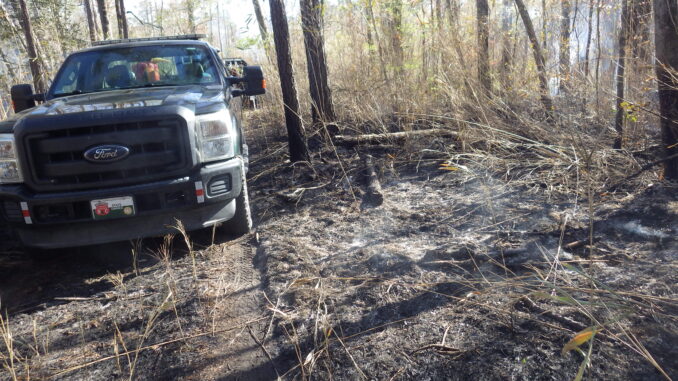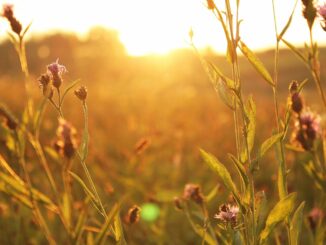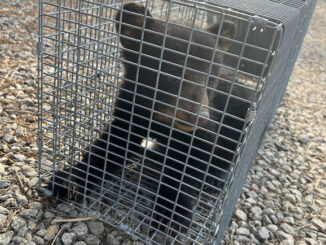
As fall fire season gets underway, state and federal forestry officials are urging extreme caution with both recreational fires and controlled burns of all sizes and kinds.
Peak fall fire season runs from October through early December, according the N.C. Forest Service. The same conditions that make it a good time to burn leaves and storm debris – mild winds, low humidity and less rainfall – make for prime wildfire conditions.
More than 99 percent of fall wildfires are manmade, the NCFS said in a press release. Not all are caused by arson. Most are the result of careless burning. Escaped fires due to careless backyard burning are the leading cause of wildfires in North Carolina, said Agriculture Commissioner Steve Troxler.
“Fall weather and the beautiful changing foliage in North Carolina draws people outdoors to take in activities such as camping, hiking or working in their yards to dispose of leaves and other yard debris,” said Troxler. “When choosing to build a campfire, grill out in your yard or eliminate leaves by burning, it is important that you remain vigilant and safe with any outdoor fire to protect our forests. You are our best defense against wildfires.”
Backyard burning is becoming more on an issue in southeastern North Carolina due to continued development of once-wild areas. Wooded areas that once saw natural burning to control debris are now suppressed due to the potential for wildfires to endanger homes. At the same time, residents of rural areas often burn leaves and storm debris to reduce vermin populations and maintain property.
Debris burns are a constant problem in most of the area, but campfires caused the state’s most intense wildfires during the fall of 2021.
In November 2021, the Sauratown Mountain Fire in Stokes County burned more than 40 acres but required 16 days to control and fully contain due to the steep and difficult terrain. Shortly after on Nov. 27, 2021, the Grindstone Fire, the largest wildfire during North Carolina’s 2021 fall wildfire season, ignited at Pilot Mountain State Park in Surry County and eventually burned 1,050 acres. Both incidents were caused by escaped campfires.
It’s not just a rural problem — a wind-whipped campfire in a Wilmington homeless camp burned multiple acres and threatened a number of homes on South 17th Street last year as well.
In fiscal 2021-22, the NCFS responded to 6,887 wildfires in the state, burning a total of 26,958. Ignition sources ranged from arson to controlled burns that escaped in fields and woods to unattended campfires, sparks from equipment and discarded smoking materials.
The N.C. Forest Service offers the following tips:
• Make sure you have a valid permit. You can obtain a burn permit at any N.C. Forest Service office or authorized permitting agent, or online at https://www.ncforestservice.gov/burn_permits/burn_permits_main.htm.
• Don’t burn on dry, windy days.
• Keep your fire small, not tall.
• Be sure you are fully prepared before burning. To control the fire, you will need a hose, bucket, steel rake and a shovel for tossing dirt on the fire. Keep a phone nearby, too.
• Never use kerosene, gasoline, diesel fuel or other flammable liquids to speed up burning.
• Douse burning charcoal briquettes or campfires thoroughly with water. Drown all embers, not just the red ones. When soaked, stir the coals and soak them again. Make sure everything is wet and that embers are cold to the touch. If you do not have water, mix enough dirt or sand with the embers to extinguish the fire, being careful not to bury the fire. Never dump hot ashes or coals into a wooded area.
• Never leave your fire. Stay with it until it is completely out.
Whenever possible, fires should be allowed to burn completely down to ash, to avoid leftover embers that can rekindle. Completely douse a fire with water, even in the areas that have been reduced to ash. Stir the water into the ash to be sure no embers remain.
Dirt or sand can be poured on a fire, but it should also be mixed into the remains. Simply burying the fire can lead to combustion of organic soil that can burn for months.
To learn more about fire safety and preventing wildfires and loss of property, visit www.ncforestservice.gov and www.smokeybear.com.For more information and tips to help create a defensible space around your home and protect your property from wildfire, visit www.resistwildfirenc.org.
















